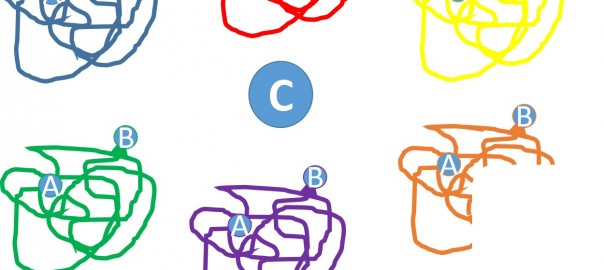I’m the proud “parent” of two cats, Sammy and Harley. As with most cats, they are fiercely independent, tending to do what they want to do, rather than what my wife and I may want them to do. (To long time followers, you’ll recognize them, I’ve written about them before.)
While I haven’t done a rigorous analysis, I suspect we are successful getting them to do “sort of” what we wanted them to do around 40% of the time. Usually, it involves some sort of bribe with food or a treat, but even then, one (usually Harley) will sniff the food, turn his nose up at it, and go off to sleep in one of his hiding places. He may eat the food later, but certainly not when we are around.
Any cat owner will attest to the difficulty in getting cats to do what you want them to do, when you want them to do it.
Helping customers navigate their buying process is increasingly like herding cats.
If it’s only one person making the decision, then we can be pretty successful navigating them through to a purchase decisions–perhaps not for us, but at least they are likely to make a decision. They may wander a little, decision-making seldom seems to be the shortest route from “A” to “B.” Along the way, they’ll get diverted by other things, change directions, shift priorities, start and stop a few times, but more often than not, we can help them navigate through to making a decision. One might imagine that decision-making or buying journey to look something like the figure A, below. It’s never straight, it wanders, covers the same ground a number of times until a decision is reached.
CEB Research (See The Challenger Customer) tells us that complex B2B buying decisions are seldom driven by one person. Their data shows 5.4 people are usually involved in complex B2B decisions. (Frankly, I think that’s understated when you start looking at influencers, recommenders, and the always unpredictable veto’ers.) Historically, the best advice has been “cover all the decision-makers.” In doing this, we work with each person, identifying their goals, priorities, needs, agenda’s, metrics, and attitudes, working separately with each person. Ideally, we get each individually bought into our solution.
Working diligently with each individual, is something like figure A, but 5.4 times. We might diagram it as I have in figure B, below. (I haven’t figured out how to draw 0.4 customers, so that weird orange thing is supposed to be 0.4 customers  )
) I suspect now you can start seeing the challenge of herding 5.4 customers through separate buying journeys. It’s a lot of work, but the real problem is, that we get them to the end of their individual buying journeys (Points B in the picture). What we need them to do, is converge on a single decision, Point C, at the same time. You can see working with customers separately, it’s virtually impossible to get them to a decision, Point C, at exactly the same time.
I suspect now you can start seeing the challenge of herding 5.4 customers through separate buying journeys. It’s a lot of work, but the real problem is, that we get them to the end of their individual buying journeys (Points B in the picture). What we need them to do, is converge on a single decision, Point C, at the same time. You can see working with customers separately, it’s virtually impossible to get them to a decision, Point C, at exactly the same time.
It turns out customers can’t make a buying journey as individuals–at least if they want to solve a problem and make a decision. They have to do it as a team. They have to align their goals, priorities, needs, agenda’s, metrics, and attitudes, at least enough to reach consensus on their definition of the problem, their goals, and the path to solving the problem.
Looking at it differently, they start their buying journey with differing points of view, with different ideas, different “maturity levels,” and so forth. We might picture it as in Figure C. As long as their points of view are separated, they will never reach a decision. We can see the challenges we have with our traditional approaches to helping customers make a buying decision. Working with each, individually, winning their support is good–but it doesn’t get a decision made because there is no commonality in their points of view or interests. Until we converge their interests, getting some overlap, as depicted in Figure D, we don’t have a chance of getting a decision made.
We can see the challenges we have with our traditional approaches to helping customers make a buying decision. Working with each, individually, winning their support is good–but it doesn’t get a decision made because there is no commonality in their points of view or interests. Until we converge their interests, getting some overlap, as depicted in Figure D, we don’t have a chance of getting a decision made.  Ultimately, the buying group’s success is based on the common ground, or convergence in interests and issues they face in the buying decision. (In this picture, it’s the area in black.) If the customer is to be successful, we have to help them find the areas of agreement, the common interests, goals, priorities, and so forth. We have to get them aligned around those issues and these issues have to be the driving factors in their decision making process. This area of alignment has to be sufficiently large to justify the investment they are making. If their common ground is not sufficiently large, while they are interested, they won’t be able to defend and justify the decision being made.
Ultimately, the buying group’s success is based on the common ground, or convergence in interests and issues they face in the buying decision. (In this picture, it’s the area in black.) If the customer is to be successful, we have to help them find the areas of agreement, the common interests, goals, priorities, and so forth. We have to get them aligned around those issues and these issues have to be the driving factors in their decision making process. This area of alignment has to be sufficiently large to justify the investment they are making. If their common ground is not sufficiently large, while they are interested, they won’t be able to defend and justify the decision being made.
As sales people, we have to find the way to draw them closer together, increasing the overlap in interests, making the area in black sufficiently large. Stated in terms of value–it’s this area of value creation that makes a difference and has an impact on our customers” abilities to reach a decision. Value creation outside this area is value that’s not important to the customer (consequently represents cost or wasted effort). While it may be important to individuals in the decision-making process, it’s irrelevant to their decision.
At this point, you may be thinking it’s hopeless or too much work trying to find common ground in 5.4 customers. (You may even be thinking a career in cat herding may be easier). In reality, it’s not that hard. Think about it a moment. In any large organization, the only way things get done is through the convergence of common interests and goals. Without this, the organization would be completely dysfunctional and would fail. Our customers already have the experience of working together, of collaborating to find common ground, a convergence of interests, a way that they can make things happen.
We need to leverage this, helping them focus, collaborate, and align on the critical issues involved in their buying decision. Working with them, as a buying team, moving them closer together, rather than farther apart will maximize that common ground and the ability for them to make and justify a decision. I’ll be sharing ideas on how we can facilitate this process, both directly and indirectly, in future posts.
Business & Finance Articles on Business 2 Community(164)









